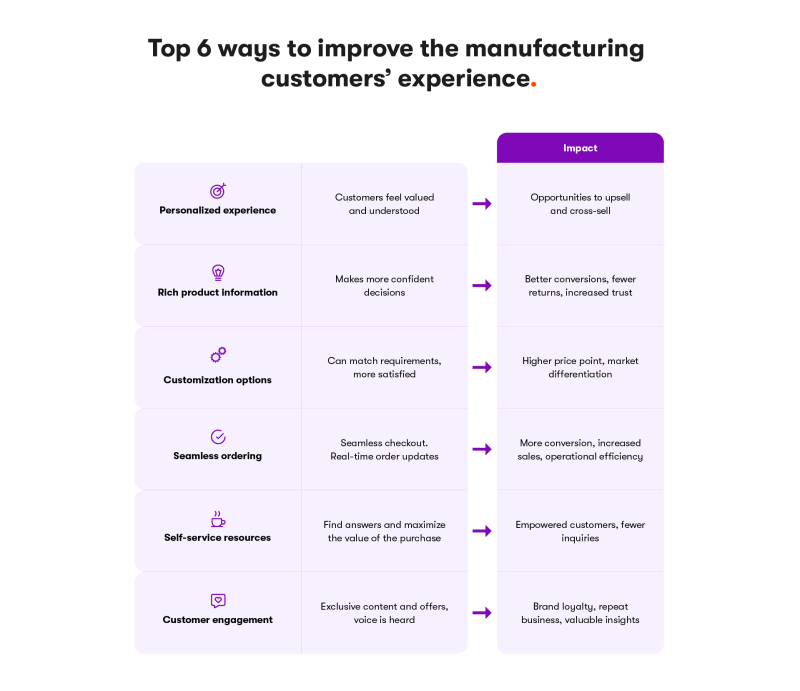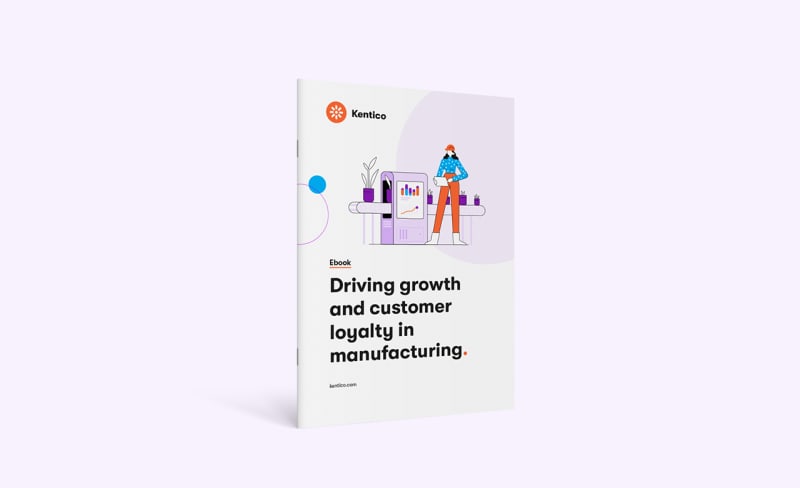In the digital age, manufacturing companies face a new frontier: the customer experience. No longer is the focus solely on producing quality goods; today's manufacturers must also excel in providing a seamless, engaging, and personalized journey for their customers.
Let’s explore the pivotal role of enhancing customer experience in manufacturing and dive into strategies that manufacturers can implement to not only meet but exceed customer expectations.
The typical manufacturing customer’s experience
Meet Sarah, who’s looking for a very specific item. Sarah begins her journey by visiting a manufacturer's website to explore their range of products. As Sarah navigates the website, she finds the layout confusing and overwhelming. She spends a considerable amount of time searching through the products, unsure about where to start.
Sarah finally finds an item that catches her eye, but the product descriptions are sparse and lack detailed information. She struggles to get a clear picture of the product's features, materials, and dimensions, leaving her uncertain about its suitability for her needs. She emails the manufacturer for more information. After a bit of back and forth, she decides to purchase. She receives an invoice with incorrect pricing, leading to confusion and more back and forth. She also has to call multiple times to check on the delivery status.
Once Sarah's item arrives, she encounters difficulty setting it up. She tries to find help on the manufacturer's website, to no avail, and so has to resort to searching online forums and social media pages for help. She leaves a negative post on the manufacturers page which gathers dozens of similar comments, but no reply.
Sarah's journey with the manufacturer is marked by frustration, confusion, and disappointment. The absence of customer-centricity not only leads to a negative experience for her but also affects the manufacturer's reputation and potential for repeat business.
Top 6 ways to improve the manufacturing customers’ experience
No matter where your manufacturing company is at with its online presence, putting the customer at the center of the experience is paramount. Let’s explore some of the ways you can do that.

1. Deliver a personalized experience
When customers can find what they need quickly, their shopping experience becomes efficient and enjoyable. Tailored recommendations introduce them to products they might not have considered. And the personal touch makes them feel valued and understood, leading to satisfaction and trust in the brand.
By providing a personalized experience, manufacturers can foster customer loyalty, increase conversions, and make relevant upsell and cross sell offers, while at the same time collecting more customer insights.
2. Provide rich product information
Detailed descriptions and visuals help customers make informed decisions. When provided with comprehensive information on features, specifications, and materials, and access to images and videos that showcase the products from different angles and across use cases, customers get a clearer picture of what to expect. This makes them feel more confident in their purchase decision.
By providing rich product information, not only can manufacturers improve conversions, but reduce returns, as informed customers are less likely to be disappointed. The approach also establishes credibility and trust, enhancing brand reputation.
3. Offer customization options
Customers want to be able to create products that suit their exact needs and preferences.
Customization gives them control over their choices, leading to a more positive buying experience, and makes them feel more attached to their purchases, enhancing their satisfaction.
By offering customization, not only are manufacturers more likely to meet customer expectations, reducing return rates, but they can often command higher prices for customized products, leading to increased revenue. It can set the brand apart in the market, attracting customers seeking personalized solutions.
4. Enable seamless ordering processes
Customers are used to convenient one-click purchases. They want to be able to place orders quickly and easily through intuitive online platforms, no matter where they are or what device they are on. They want real-time order tracking with updates on production, shipping, and delivery, giving them peace of mind and trust in the process.
Manufacturers that can provide easy and convenient ordering processes will not only see happier customers (and more of them) but also higher conversion rates and increased sales. What’s more, streamlined processes are likely to save time and resources internally too, improving overall operational efficiency.
5. Self-service resources
Self-services areas allow customers to find answers and troubleshoot issues independently through online resources like FAQs and troubleshooting guides, oftentimes replacing the need to contact customer support. Customers feel empowered to maximize the value of their purchase through knowledge bases and how-to guides, improving their overall experience.
From the manufacturer’s perspective, self-service resources decrease the volume of basic customer inquiries, allowing support teams to focus on more complex issues. Empowered customers are happy customers.
6. Customer feedback and engagement
Engagement platforms like social media, email newsletters, and loyalty programs offer customers exclusive content and promotions, adding value to their relationship with the brand. While feedback loops allow customers to have their voices heard, knowing that their opinions matter.
Engaging with customers through various platforms builds brand loyalty and encourages repeat business. And not only does customer feedback provide valuable insights for product innovation, helping manufacturers stay ahead of market trends, but listening to and acting on customer feedback enhances the brand's reputation for customer-centricity and responsiveness.
The ideal manufacturing customer’s experience
Let’s see what happens when Sarah chooses a customer-centric manufacturer for her purchase:
Sarah begins her journey by visiting the manufacturer's website to explore their range of products. As she navigates the site, she notices personalized recommendations tailored to her previous purchases and preferences. Intrigued by these suggestions, she discovers a more feature-full (higher priced) model, and she delves deeper into the product descriptions and high-quality images to learn more about the product. Now confident in her choice, Sarah uses the customization options to ensure it meets her exact specifications.
Once satisfied with her customized product, Sarah proceeds to place her order. The online ordering platform is intuitive and user-friendly, allowing her to complete the purchase quickly and easily. As she confirms her order, she opts to receive real-time updates on its status. Throughout the production, shipping, and delivery process, Sarah receives notifications, keeping her informed and reassured.
A few days later, Sarah's product arrives, however, she encounters a minor issue during setup. Instead of reaching out to customer support, Sarah visits the online knowledge base and finds a troubleshooting guide that helps her resolve the issue in minutes.
Delighted with her purchase experience, Sarah decides to follow the manufacturer on social media. She discovers an engaged community, exclusive content, and promotions that keep her connected to the brand. The manufacturer's email newsletters provide her with valuable tips and updates. Impressed by the brand's attentiveness, Sarah decides to share her positive experience with friends and colleagues, becoming an advocate for the brand.
What’s good for them is good for you
The tale of Sarah's contrasting experiences with manufacturers illustrates a pivotal truth: customer-centricity is not just beneficial; it's essential for success. Manufacturers must recognize that every interaction with a customer is an opportunity to build trust, loyalty, and advocacy. From personalized recommendations to customization options, seamless ordering processes, rich product information, self-service support, and engaging feedback loops, every step of the journey should be designed to enhance the customer experience.
In today's market, what's good for the customer is undeniably good for the manufacturer. By putting the customer at the center of the experience, manufacturers not only enhance customer satisfaction and loyalty but also differentiate themselves in a crowded marketplace. The path to success in manufacturing is clear: prioritize the customer journey, and watch as loyalty and advocacy pave the way to growth and success.
Dive deeper into how you can transform your customer experience
If this sounds like the direction you want to go, then download our comprehensive ebook Driving growth and customer loyalty in manufacturing.
Subscribe to the Kentico Xperience newsletter
You'll receive our newsletter once a month with all the updates you need to know to keep you in the loop with the Kentico Xperience community. Just the hits—guaranteed.


